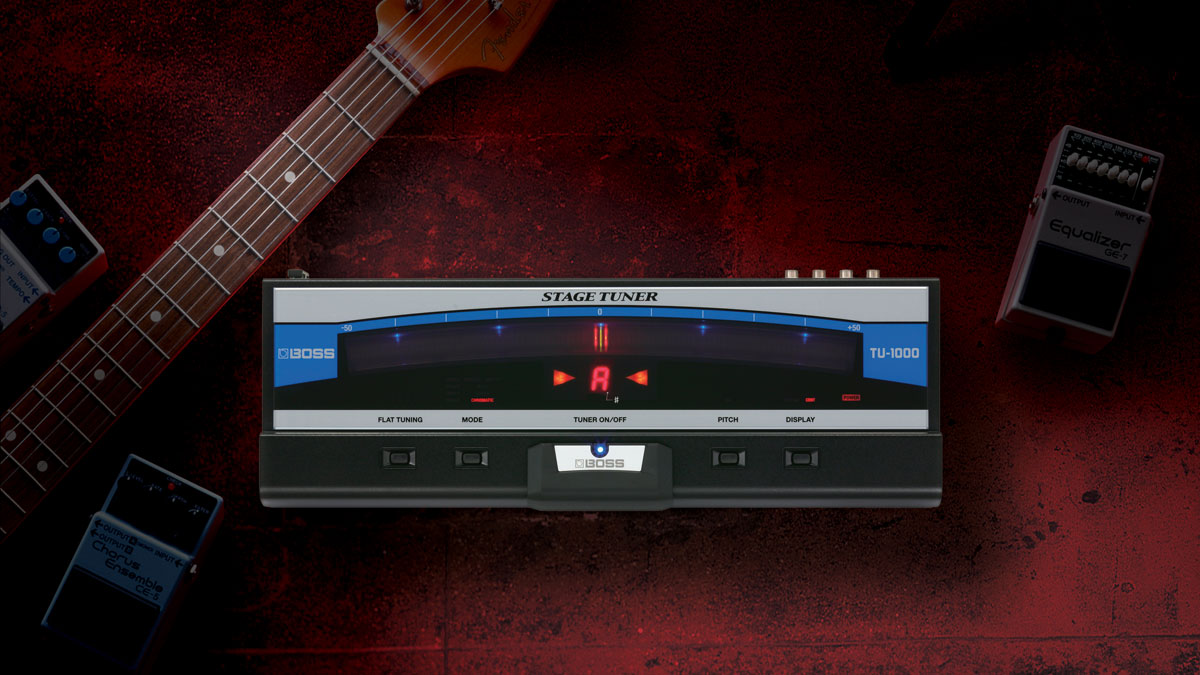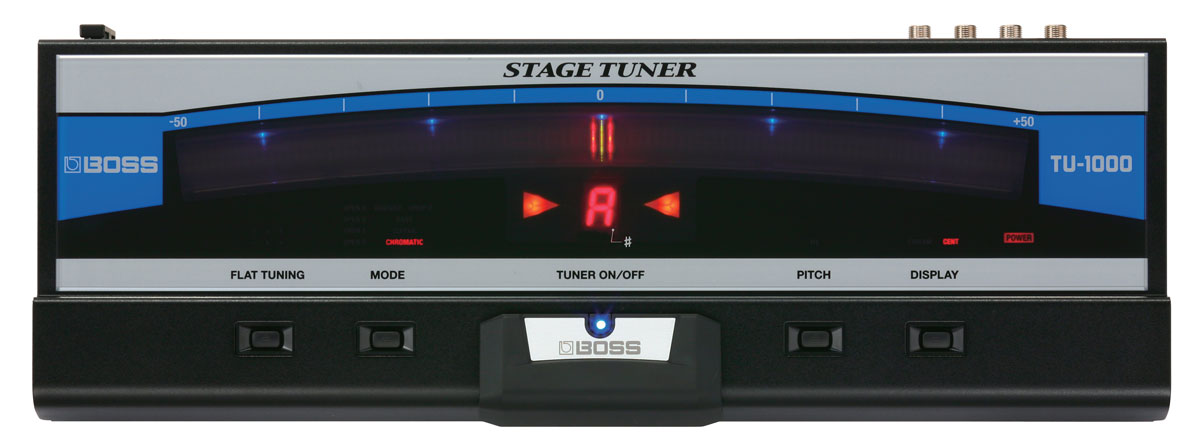Remembering the Boss TU-1000 – the gigantic, pedalboard-dwarfing tuner pedal that launched a hundred memes
One of the largest pedals ever released, the enormous tuner quickly became the subject of guitarists’ ridicule – but it did eventually find an audience

Forget your overdrives, your delays and your reverbs: the humble tuner pedal is the most important stompbox on your pedalboard. Nothing will improve your tone more than being in tune. Fact.
It’s why, when Boss launched the first compact pedal tuner in 1998, it quickly became a new industry standard. The TU-2 had finally satisfied guitarists’ and bassists’ need for a quick, reliable way to tune their guitars mid-show. It was a game-changer.
A decade later, the TU-2 was still riding high. Yet Boss was developing the next generation of tuners, and sought to solve a problem raised by several guitar players over the years: visibility.
No doubt, the TU-2’s small LED display could be tricky to read in the glare of stage lights or harsh sunlight. The TU-3, which boasted a high-brightness mode, as well as a 21-segment LED meter, would eventually rectify these issues in 2010.
But prior to the more obvious revamp of its debut compact pedal tuner, Boss’s solution to the visibility problem was to release a stompbox so over-engineered, so unwieldy, so gosh darn enormous you wouldn’t believe it to be real if it hadn’t actually existed.
When it launched at Winter NAMM 2009, the TU-1000 was billed as “pro-caliber tuning for the stage floor” and anointed the flagship of Boss’s tuner range – presumably because it was almost the size of a small naval vessel.
my therapist: the BOSS TU-1000 Stage Tuner is discontinued. it can't hurt you and you can't buy onethe BOSS TU-1000 Stage Tuner: pic.twitter.com/8r95Rn3u58August 25, 2020
The TU-1000 was 414mm wide. To put that into perspective, a Pedaltrain Nano pedalboard – which fits four standard-sized stompboxes – measures 355mm wide.
Get The Pick Newsletter
All the latest guitar news, interviews, lessons, reviews, deals and more, direct to your inbox!
Guitarists don’t like big tuners, as evidenced by the wave of mini tuner pedals released throughout the 2010s. But this thing was huge. So huge, in fact, that Gearwire (remember them?) released a video entitled ‘Boss TU-1000 Guitar Tuner Dwarfed Only By The Size And Scope Of Winter NAMM Itself’. Even the on-camera Boss rep runs out of things to say in the promo clip, ending her 56-second pitch with: “If you need a tuner, this is a big one.” No arguments here.
Boss did its best to extol the virtues of sticking what was essentially a rack tuner on the floor. There were two tuning modes. It could handle open and drop tunings. There was power for up to seven Boss pedals. What about that pair of outputs, huh? And er, that glowing blue Boss logo on the rear panel, which was described as “an eye-catcher”.
But the “high-visibility design”, achieved primarily by making the pedal positively ginormous, was the only USP guitarists cared about.
It wasn’t long before the first wave of memes dropped. These were the halcyon days of Harmony Central, and while the message board’s 38-page, three-long-year-long thread still exists, many of the rudimentary Photoshop efforts are lost to the mists of now-defunct TinyPic accounts.
Thankfully, a handful of these visual funnies were preserved by an enterprising Twitter user, depicting the TU-1000 as an aircraft carrier, a Stonehenge pillar and one of The Lord of the Rings’ Two Towers.
幅41cm、重さ2.2kgという巨大さに誰もが驚愕したBOSS TU-1000 ステージチューナー。海外でも愛されているようでクソコラが大量に作られています。リンク先は笑いたいときに最適。http://t.co/fzDhErtGKo pic.twitter.com/5ogkmhmrLLAugust 12, 2015
Elsewhere, the TU-1000 was Photoshopped into the Statue of Liberty’s arms, transformed into a UFO attacking the White House in Independence Day, and even took the place of John Frusciante’s gigantic early noughties pedalboard.
Unfortunately, TU-1000 memes did not translate to TU-1000 sales. Launched in 2009 for $299, retailers were reportedly blowing the tuners out for as little as $39 when the production line ground to a halt in 2015. The company itself seems to have forgotten its former flagship, too, omitting it from its online history of Boss tuners, although the tuner’s product page remains.

Despite the widespread scepticism surrounding a tuner of such proportions, the pedal did find a user base. That large display was of genuine benefit to visually impaired guitarists, such as country great Johnny Hiland, who endorsed and used the unit shortly after its launch.
The TU-1000 continues to sell online from time to time, with prices currently fluctuating between $63 and $131 on Reverb. User comments are unanimously positive, with older players and those who struggle to see regular tuners praising the unit’s clear visibility in particular.
It may have been Boss’s biggest flop – quite literally – but the TU-1000 serves as a reminder that even the most unloved gear can find its purpose with the right audience… even if Boss wasn’t quite in tune with the market at large.

Mike is Editor-in-Chief of GuitarWorld.com, in addition to being an offset fiend and recovering pedal addict. He has a master's degree in journalism from Cardiff University, and over a decade's experience writing and editing for guitar publications including MusicRadar, Total Guitar and Guitarist, as well as 20 years of recording and live experience in original and function bands. During his career, he has interviewed the likes of John Frusciante, Chris Cornell, Tom Morello, Matt Bellamy, Kirk Hammett, Jerry Cantrell, Joe Satriani, Tom DeLonge, Ed O'Brien, Polyphia, Tosin Abasi, Yvette Young and many more. In his free time, you'll find him making progressive instrumental rock under the nom de plume Maebe.
“Jimi was staying at a hotel in Times Square. He had his hair set in pink curlers and we would just talk band drama”: Electro-Harmonix founder Mike Matthews on befriending Hendrix, booking Chuck Berry and the birth of pedal culture
“Our answer to everything players have asked for and more”: Neural DSP’s Nano Cortex had one major drawback – but now it’s been addressed with a huge free firmware update that takes on Kemper and TONEX




![[from left] George Harrison with his Gretsch Country Gentleman, Norman Harris of Norman's Rare Guitars holds a gold-top Les Paul, John Fogerty with his legendary 1969 Rickenbacker](https://cdn.mos.cms.futurecdn.net/TuH3nuhn9etqjdn5sy4ntW.jpg)





